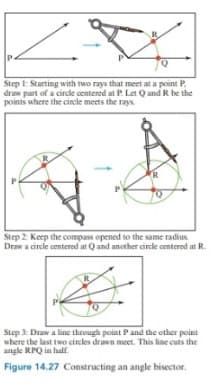Draw a rhombus that is naturally associated with the straightedge and compass construc-tion of a ray dividing an angle in half shown in Figure 14.27. b. Explain why the quadrilateral that you identify as a rhombus in part (a) really must be a rhombus, according to the definition of rhombus and according to the way it was constructed. c. Why does the construction in Figure 14.27 work? Use a special property of rhombuses to explain why the construction produces a ray that divides the given angle at P in half.
Draw a rhombus that is naturally associated with the straightedge and compass construc-tion of a ray dividing an angle in half shown in Figure 14.27. b. Explain why the quadrilateral that you identify as a rhombus in part (a) really must be a rhombus, according to the definition of rhombus and according to the way it was constructed. c. Why does the construction in Figure 14.27 work? Use a special property of rhombuses to explain why the construction produces a ray that divides the given angle at P in half.
Linear Algebra: A Modern Introduction
4th Edition
ISBN:9781285463247
Author:David Poole
Publisher:David Poole
Chapter1: Vectors
Section1.2: Length And Angle: The Dot Product
Problem 7AEXP
Related questions
Question
Draw a rhombus that is naturally associated with the straightedge and compass construc-tion of a ray dividing an
b. Explain why the quadrilateral that you identify as a rhombus in part (a) really must be a rhombus, according to the definition of rhombus and according to the way it was constructed.
c. Why does the construction in Figure 14.27 work? Use a special property of rhombuses to explain why the construction produces a ray that divides the given angle at P in half.

Transcribed Image Text:ZXXXX
Step 1: Starting with two rays that meet at a point P
draw part of a circle centered at P. Let Q and R be the
points where the circle meets the rays
R
Step 2: Keep the compass opened to the same radius
Draw a circle centered at Q and another circle centered at R.
Step 3: Draw a line through point P and the other point
where the last two circles drawn meet. This line cuts the
angle RPQ in half.
Figure 14.27 Constructing an angle bisector.
Expert Solution
This question has been solved!
Explore an expertly crafted, step-by-step solution for a thorough understanding of key concepts.
This is a popular solution!
Trending now
This is a popular solution!
Step by step
Solved in 3 steps with 3 images

Recommended textbooks for you

Linear Algebra: A Modern Introduction
Algebra
ISBN:
9781285463247
Author:
David Poole
Publisher:
Cengage Learning

Elementary Geometry For College Students, 7e
Geometry
ISBN:
9781337614085
Author:
Alexander, Daniel C.; Koeberlein, Geralyn M.
Publisher:
Cengage,

Elementary Geometry for College Students
Geometry
ISBN:
9781285195698
Author:
Daniel C. Alexander, Geralyn M. Koeberlein
Publisher:
Cengage Learning

Linear Algebra: A Modern Introduction
Algebra
ISBN:
9781285463247
Author:
David Poole
Publisher:
Cengage Learning

Elementary Geometry For College Students, 7e
Geometry
ISBN:
9781337614085
Author:
Alexander, Daniel C.; Koeberlein, Geralyn M.
Publisher:
Cengage,

Elementary Geometry for College Students
Geometry
ISBN:
9781285195698
Author:
Daniel C. Alexander, Geralyn M. Koeberlein
Publisher:
Cengage Learning

Algebra & Trigonometry with Analytic Geometry
Algebra
ISBN:
9781133382119
Author:
Swokowski
Publisher:
Cengage

Mathematics For Machine Technology
Advanced Math
ISBN:
9781337798310
Author:
Peterson, John.
Publisher:
Cengage Learning,

Trigonometry (MindTap Course List)
Trigonometry
ISBN:
9781305652224
Author:
Charles P. McKeague, Mark D. Turner
Publisher:
Cengage Learning